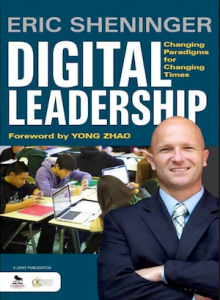An Inspiring Look at Leadership for Digital Learning
Digital Leadership: Changing Paradigms for Changing Times
By Eric Sheninger
(Corwin, 2014 – Learn more)

Digital Leadership: Changing Paradigms for Changing Times by Eric Sheninger is a handbook both for administrators who are interested in integrating technology in schools, and for teachers, parents, politicians and community members who want a better understanding of why this change in paradigms is so important.
Sheninger’s book is a practical explanation of the responsibility that our schools have to prepare our students for the technological world into which they were born and already have to contend with. Sheninger explains that as schools fail to transition into this new technological paradigm, a disconnect forms between stakeholders and schools, and “The longer this disconnect continues, the more meaningless and irrelevant our schools become to our students” (p. 5).
Beyond my expectations

Sheninger does include that information in the book. However, to my surprise, he also highlights other administrators throughout the country who have also transitioned into digital leaders, using their work as well as his own to help define his seven Pillars of Digital Leadership: communication, public relations, branding, student engagement/learning, professional growth/development, re-envisioning learning spaces and environments, and opportunity.
For example, in his explanation of communication, he highlights Joe Mazza, the principal of Knapp Elementary School in suburban Philadelphia, who utilizes virtual school meetings to connect to parents “where they are” (p. 77). He also includes John Carver, superintendent of schools for the Howard-Winneshiek Community School District in Iowa, to demonstrate the effect that social media can have on public relations.
I appreciated Sheninger’s effort to demonstrate how leaders in varying roles and school districts have utilized and transitioned to digital leadership, while also sharing his own stories from New Milford.
Breaking down the resources
I also enjoyed Sheninger’s explanations of specific resources, including their strengths and weaknesses. For example, he explains Chromebooks and the value they have, but also notes, “The major drawback to the Chromebook is that if the Internet is down, the device has limited functionality” (p. 8). In my opinion, that is great, practical information that helps anyone trying to decide on what devices to incorporate. This is just one example – Sheninger offers the same treatment to other devices he discusses.
Finally, I was extremely impressed with the frequent references to forward-thinking educational leaders and motivational and change experts. For example, Sheninger cites Michael Fullan’s Six Secrets of Change (p. 53-57), as well as Daniel Pink’s motivational research (p. 39-40). He also shares insights from George Couros, division principal of innovative teaching and learning for the Parkland School Division in Stony Plain, Alberta, Canada, and from Mark Prensky, consultant and designer in education.
Inspiring and frustrating
Over the course of Digital Leadership, Sheninger succeeds in combining all the necessary elements to assist anyone considering the transition to digital leadership in education. I found Sheninger’s book full of insightful and practical information for administrators (and future administrators) who want to transform themselves into digital leaders.
As a teacher who has to get permission to allow students to use their own devices, all set to airplane mode, I was somewhat frustrated by Sheninger’s book because I am not in the position to make the changes that I see as inevitable and necessary.
I am currently serving as the professional development subcommittee chair of our school improvement team, and I really like the idea of the Professional Growth Period (PGP) that Sheninger has implemented in support of his contention that “autonomy breeds change.” The PGP digital learning portfolio is a great artifact to present as evidence.
As I complete my review, I am looking forward to discreetly dropping off my copy of the book on my principal’s desk for his summer reading enjoyment!
Kristen Peterson has been an educator in Indiana for 15 years. She is licensed in and has taught U.S. History, U.S. Government, Psychology, Sociology, Health and Physical Education in grades 7-12. She served as varsity head basketball coach for 10 years before deciding to pursue an administrator’s license and spend more time with her two children. Currently, she teaches Physical Education at Chesterton Middle School. She enjoys reading as much as she can about how to improve education and instruction, preparing herself for when and if she transitions to administration.



































